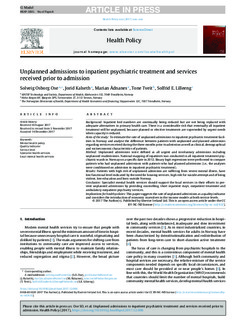| dc.contributor.author | Ose, Solveig Osborg | |
| dc.contributor.author | Kalseth, Jorid | |
| dc.contributor.author | Ådnanes, Marian | |
| dc.contributor.author | Tveit, Tone | |
| dc.contributor.author | Lilleeng, Solfrid | |
| dc.date.accessioned | 2018-03-13T10:55:13Z | |
| dc.date.available | 2018-03-13T10:55:13Z | |
| dc.date.created | 2018-01-29T18:39:27Z | |
| dc.date.issued | 2017 | |
| dc.identifier.issn | 0168-8510 | |
| dc.identifier.uri | http://hdl.handle.net/11250/2490265 | |
| dc.description.abstract | Background Inpatient bed numbers are continually being reduced but are not being replaced with adequate alternatives in primary health care. There is a considerable risk that eventually all inpatient treatment will be unplanned, because planned or elective treatments are superseded by urgent needs when capacity is reduced. Aims of the study To estimate the rate of unplanned admissions to inpatient psychiatric treatment facilities in Norway and analyse the difference between patients with unplanned and planned admissions regarding services received during the three months prior to admission as well as clinical, demographical and socioeconomic characteristics of patients. Method Unplanned admissions were defined as all urgent and involuntary admissions including unplanned readmissions. National mapping of inpatients was conducted in all inpatient treatment psychiatric wards in Norway on a specific date in 2012. Binary logit regressions were performed to compare patients who had unplanned admissions with patients who had planned admissions (i.e., the analyses were conditioned on admission to inpatient psychiatric treatment). Results Patients with high risk of unplanned admission are suffering from severe mental illness, have low functional level indicated by the need for housing services, high risk for suicide attempt and of being violent, low education and born outside Norway. Conclusion Specialist mental health services should support the local services in their efforts to prevent unplanned admissions by providing counselling, short inpatient stays, outpatient treatment and ambulatory outpatient psychiatry services. Implications for health policies This paper suggests the rate of unplanned admissions as a quality indicator and considers the introduction of economic incentives in the income models at both service levels. | nb_NO |
| dc.language.iso | eng | nb_NO |
| dc.rights | Attribution-NonCommercial-NoDerivatives 4.0 Internasjonal | * |
| dc.rights | Attribution-NonCommercial-NoDerivatives 4.0 Internasjonal | * |
| dc.rights.uri | http://creativecommons.org/licenses/by-nc-nd/4.0/deed.no | * |
| dc.title | Unplanned Admissions to Inpatient Psychiatric Treatment and Services Received Prior to Admission | nb_NO |
| dc.type | Journal article | nb_NO |
| dc.type | Peer reviewed | nb_NO |
| dc.description.version | publishedVersion | nb_NO |
| dc.source.journal | Health Policy | nb_NO |
| dc.identifier.doi | 10.1016/j.healthpol.2017.12.006 | |
| dc.identifier.cristin | 1555392 | |
| cristin.unitcode | 7401,60,25,0 | |
| cristin.unitname | Helse | |
| cristin.ispublished | true | |
| cristin.fulltext | original | |
| cristin.qualitycode | 1 | |

